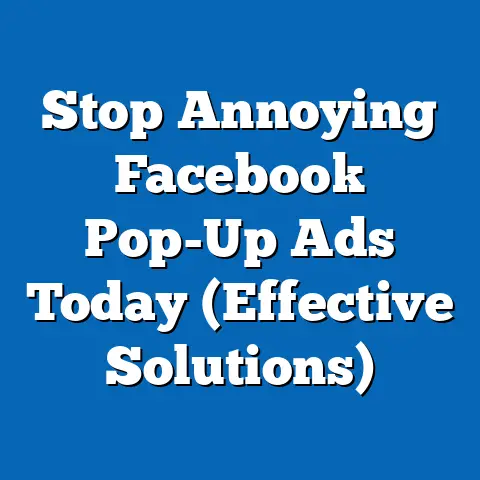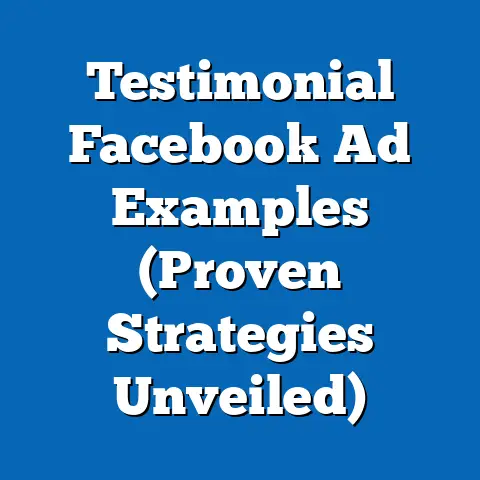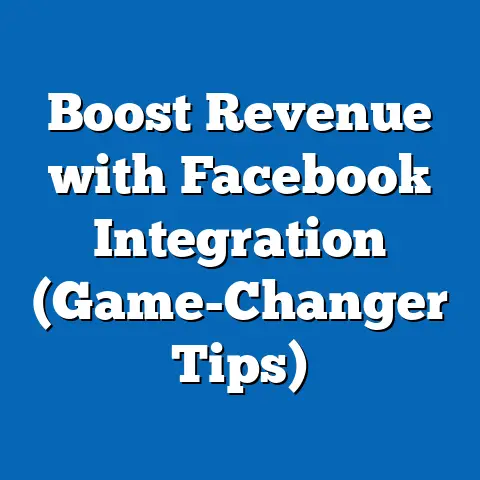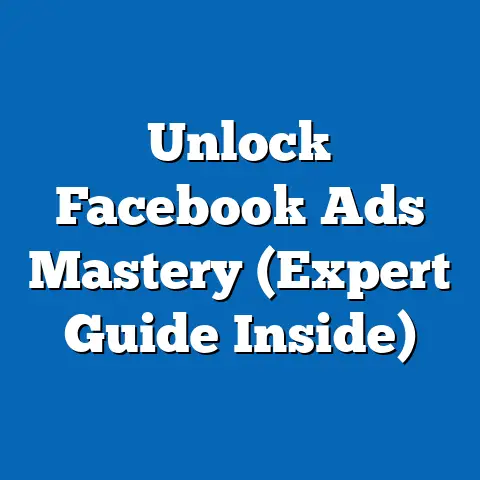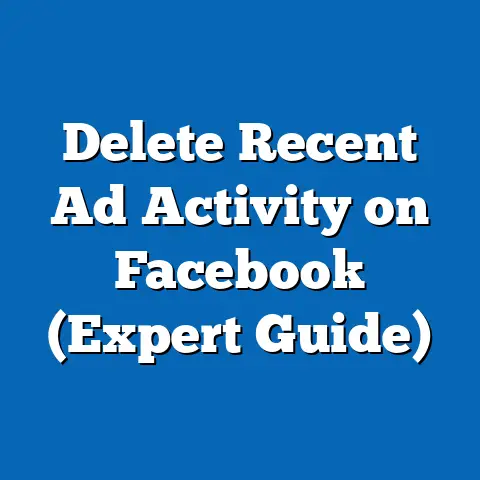Master Clock Facebook Ads (Proven Strategies Unveiled)
The Importance of Facebook Ads in Today’s Digital Landscape
The digital landscape has transformed drastically over the past decade, and social media advertising has emerged as a cornerstone of modern marketing strategies. No longer can businesses solely rely on traditional methods; they must adapt to where their audience spends their time – online, and often on social media platforms like Facebook.
Facebook, with its massive user base and sophisticated targeting capabilities, offers an unparalleled opportunity for businesses to connect with potential customers. Consider this: Facebook boasts over 2.9 billion monthly active users as of early 2024. That’s nearly half the world’s population! This sheer reach makes Facebook an incredibly powerful platform for brand visibility.
Furthermore, Facebook’s advertising platform allows for granular targeting. You can target users based on demographics (age, gender, location), interests (hobbies, pages they like), behaviors (purchase history, online activities), and even their connections (friends of fans). This level of precision ensures that your ads are seen by the people most likely to be interested in your product or service, maximizing your ROI.
I’ve seen firsthand how impactful a well-executed Facebook ad campaign can be. Early in my career, I worked with a small local bakery struggling to gain traction. By implementing targeted Facebook ads, showcasing mouthwatering photos of their pastries and focusing on local residents interested in food and dining, we saw a 30% increase in foot traffic within a month. This success story highlights the potential of Facebook ads to enhance brand visibility, drive engagement, and contribute to overall business success.
Key Takeaway: Facebook advertising is no longer an option but a necessity for businesses looking to thrive in today’s digital landscape. Its massive reach and sophisticated targeting capabilities make it a powerful tool for enhancing brand visibility and driving engagement.
Understanding the Master Clock Concept in Facebook Ads
Imagine a symphony orchestra. Each instrument plays its part, but it’s the conductor who ensures everything is in perfect harmony, playing at the right time and in the right sequence. The “Master Clock” concept in Facebook ads is similar; it’s about understanding and leveraging the optimal timing and strategy to maximize your campaign’s effectiveness.
Timing plays a crucial role in ad performance. Consider peak hours for user engagement. When are your target customers most active on Facebook? Are they more likely to be scrolling through their feeds during their lunch break, in the evening after work, or on weekends? Understanding these patterns can help you schedule your ads to reach them when they’re most receptive. Facebook’s ad scheduling feature allows you to specify the days and times your ads are displayed, ensuring they’re seen when your audience is most likely to engage.
But the Master Clock isn’t just about timing; it’s also about understanding your audience’s “clock.” What are their needs, desires, and pain points? What type of messaging resonates with them? Effective audience segmentation is key to unlocking this understanding. By dividing your audience into distinct groups based on their characteristics and behaviors, you can tailor your ad copy and visuals to speak directly to their specific needs.
For example, if you’re selling fitness products, you might segment your audience into “beginners,” “intermediate,” and “advanced” fitness enthusiasts. Each group will have different goals and motivations, requiring a tailored approach in your ad messaging. A beginner might be motivated by ads that focus on ease of use and quick results, while an advanced user might be more interested in ads that highlight advanced features and performance metrics.
Key Takeaway: The Master Clock concept in Facebook ads emphasizes the importance of timing and audience segmentation. Understanding when your target customers are most active and tailoring your messaging to their specific needs can significantly improve your campaign’s performance.
Proven Strategies for Mastering Facebook Ads
Now that we understand the importance of Facebook ads and the concept of the Master Clock, let’s dive into proven strategies to help you master the platform.
Strategy 1: Crafting Compelling Ad Copy
Your ad copy is your first (and sometimes only) chance to grab your audience’s attention. It needs to be persuasive, engaging, and relevant to their needs. Here are some key elements of compelling ad copy:
- Clear Call to Action (CTA): Tell your audience exactly what you want them to do. Use strong action verbs like “Shop Now,” “Learn More,” “Sign Up,” or “Get Started.” Make your CTA prominent and easy to find.
- Emotional Triggers: Tap into your audience’s emotions to create a connection. Use language that evokes feelings of excitement, curiosity, fear of missing out (FOMO), or a desire for belonging.
- Storytelling Techniques: Weave a narrative that resonates with your audience. Share a customer success story, highlight a problem your product solves, or create a sense of intrigue that encourages them to learn more.
I once worked with an e-commerce company selling handmade jewelry. Instead of simply listing the features of their products, we crafted ad copy that told the story behind each piece. We highlighted the artisan’s craftsmanship, the unique materials used, and the inspiration behind the design. This storytelling approach resonated deeply with their target audience, resulting in a significant increase in sales.
Example:
- Bad Ad Copy: “Handmade jewelry for sale! Shop now!”
- Good Ad Copy: “Discover the artistry behind our handcrafted jewelry. Each piece is lovingly made by skilled artisans using ethically sourced materials. Find the perfect piece to express your unique style. Shop now and support independent creators!”
Key Takeaway: Compelling ad copy is essential for capturing your audience’s attention and driving conversions. Use clear CTAs, emotional triggers, and storytelling techniques to create a connection with your target customers.
Strategy 2: Utilizing Eye-Catching Visuals
In a world saturated with information, visuals are crucial for standing out. Facebook is a visually driven platform, and your ads need to grab attention within seconds. Here are some tips for utilizing eye-catching visuals:
- High-Quality Images: Use professional-quality images that are clear, well-lit, and visually appealing. Avoid blurry or pixelated images.
- Engaging Videos: Videos are incredibly effective at capturing attention and conveying information. Create short, engaging videos that showcase your product or service in action.
- Carousel Ads: Carousel ads allow you to display multiple images or videos in a single ad unit. This format is great for showcasing a range of products or highlighting different features of a single product.
When I’m scrolling through my feed, I always stop when I see a visually appealing ad. I remember one ad in particular for a travel company. It featured a stunning video of a couple exploring a tropical island, complete with crystal-clear water, white sandy beaches, and lush greenery. The video was so captivating that I immediately clicked on the ad to learn more about their travel packages.
Key Takeaway: Eye-catching visuals are essential for grabbing attention and driving engagement on Facebook. Use high-quality images, engaging videos, and carousel ads to showcase your product or service in a visually appealing way.
Strategy 3: Leveraging Facebook’s Targeting Options
Facebook’s targeting options are incredibly powerful, allowing you to reach specific audiences based on their demographics, interests, and behaviors. Here’s a breakdown of the key targeting options:
- Demographic Targeting: Target users based on age, gender, location, education, relationship status, and other demographic factors.
- Interest-Based Targeting: Target users based on their interests, hobbies, and the pages they like on Facebook.
- Behavioral Targeting: Target users based on their online behavior, such as their purchase history, travel habits, and device usage.
- Custom Audiences: Create custom audiences by uploading your own customer data, such as email addresses or phone numbers. This allows you to target your existing customers with tailored ads.
- Lookalike Audiences: Create lookalike audiences by identifying users who share similar characteristics and behaviors with your existing customers. This is a great way to expand your reach and find new potential customers.
I once used Facebook’s targeting options to help a local bookstore promote a new book release. We targeted users who were interested in reading, books, and literature, as well as those who had liked pages related to the book’s genre. We also created a lookalike audience based on the bookstore’s existing customers. This targeted approach resulted in a significant increase in book sales and website traffic.
Key Takeaway: Facebook’s targeting options are incredibly powerful, allowing you to reach specific audiences based on their demographics, interests, and behaviors. Use custom audiences and lookalike audiences to maximize your ad reach and find new potential customers.
Strategy 4: A/B Testing for Optimization
A/B testing, also known as split testing, is the process of comparing two versions of an ad to see which one performs better. This is a crucial step in optimizing your Facebook ad campaigns. Here’s how to set up A/B tests effectively:
- Identify Elements to Test: Focus on testing one element at a time, such as the ad copy, visuals, CTA, or targeting options.
- Create Variations: Create two versions of your ad, each with a different variation of the element you’re testing.
- Set Up Your Test: Use Facebook’s A/B testing feature to split your audience and show each version of the ad to a different group of people.
- Analyze Results: Track the performance of each version of the ad and identify which one performs better based on your chosen metrics, such as click-through rates, conversion rates, or cost per acquisition.
For example, you might want to test two different headlines for your ad copy. Version A might use a benefit-driven headline, while Version B might use a question-based headline. By running an A/B test, you can determine which headline resonates better with your audience and use that information to optimize your ad copy.
Key Takeaway: A/B testing is essential for optimizing your Facebook ad campaigns. Test different elements of your ads to identify what resonates best with your audience and improve your overall performance.
Strategy 5: Analyzing Ad Performance Metrics
Tracking and analyzing your ad performance metrics is crucial for understanding what’s working and what’s not. Here are some key performance indicators (KPIs) to track:
- Click-Through Rate (CTR): The percentage of people who see your ad and click on it. A higher CTR indicates that your ad is relevant and engaging.
- Conversion Rate: The percentage of people who click on your ad and complete a desired action, such as making a purchase or signing up for a newsletter.
- Cost Per Click (CPC): The amount you pay each time someone clicks on your ad.
- Cost Per Acquisition (CPA): The amount you pay to acquire a new customer.
- Return on Ad Spend (ROAS): The amount of revenue you generate for every dollar you spend on advertising.
I always tell my clients to focus on ROAS as their primary metric. It gives you a clear picture of how much money you’re making for every dollar you spend on advertising. By tracking ROAS, you can identify which campaigns are generating the most revenue and allocate your budget accordingly.
Key Takeaway: Analyzing your ad performance metrics is crucial for understanding what’s working and what’s not. Track key KPIs such as CTR, conversion rate, CPC, CPA, and ROAS to optimize your campaigns and maximize your ROI.
Real-Life Case Studies
Let’s look at some real-life examples of businesses that have successfully implemented the Master Clock strategies in their Facebook ad campaigns.
Case Study 1: Local Restaurant
A local restaurant was struggling to attract customers during weekday lunch hours. They implemented a targeted Facebook ad campaign, focusing on local residents and office workers who were interested in food and dining. They scheduled their ads to run during lunchtime hours, showcasing mouthwatering photos of their lunch specials and offering a special discount for first-time customers. As a result, they saw a 20% increase in lunchtime customers within a month.
Case Study 2: Online Clothing Boutique
An online clothing boutique wanted to increase sales of their new spring collection. They created a series of carousel ads showcasing different outfits from the collection, targeting users who were interested in fashion and online shopping. They used compelling ad copy that highlighted the latest trends and offered free shipping on orders over $50. They also ran A/B tests to optimize their ad copy and visuals. This targeted campaign resulted in a 30% increase in sales of their spring collection.
Key Takeaway: These case studies demonstrate the effectiveness of the Master Clock strategies in driving real-world results. By understanding your audience’s needs, tailoring your messaging, and optimizing your campaigns, you can achieve significant success with Facebook advertising.
Common Pitfalls to Avoid
While Facebook advertising offers incredible potential, it’s also easy to make mistakes that can derail your campaigns. Here are some common pitfalls to avoid:
- Neglecting Audience Research: Failing to understand your target audience’s needs and desires is a recipe for disaster. Take the time to research your audience and create detailed buyer personas.
- Failing to Optimize for Mobile Devices: The majority of Facebook users access the platform on their mobile devices. Make sure your ads are optimized for mobile viewing, with clear visuals and concise copy.
- Ignoring Ad Fatigue: Running the same ads for too long can lead to ad fatigue, where your audience becomes desensitized to your messaging. Refresh your ads regularly to keep them engaging.
- Not Tracking Your Results: Failing to track your ad performance metrics is like driving a car without a speedometer. You need to monitor your results to understand what’s working and what’s not.
- Setting It and Forgetting It: Facebook advertising is not a “set it and forget it” activity. You need to continuously monitor your campaigns, analyze your results, and make adjustments as needed.
I’ve seen businesses waste thousands of dollars on Facebook ads simply because they didn’t take the time to research their audience or optimize their campaigns. Don’t let this happen to you!
Key Takeaway: Avoid these common pitfalls to ensure a smoother advertising experience and maximize your ROI. Take the time to research your audience, optimize for mobile devices, refresh your ads regularly, track your results, and continuously monitor your campaigns.
Conclusion
Mastering Facebook ads is essential for achieving marketing success in today’s digital landscape. By understanding the importance of timing, targeting, and crafting compelling content, you can unlock the potential of Facebook advertising and drive real-world results. Remember to craft compelling ad copy, utilize eye-catching visuals, leverage Facebook’s targeting options, A/B test for optimization, and analyze your ad performance metrics.
Don’t be afraid to experiment, test new strategies, and continuously learn and adapt. With the right timing and approach, you too can master the art of Facebook advertising and achieve your marketing goals. So, what are you waiting for? Start applying these strategies in your ad campaigns today!

